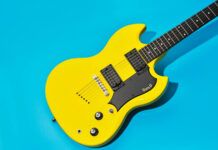
Five best DAWs for guitarists in 2020
Recording DIY-style is now easier than ever, thanks to the wealth of powerful audio interfaces and programs available. But if you’re a guitarist in the market for a Digital Audio Workstation, which of the many options should you invest in?
Headline aside, the best DAW for you definitely depends on what you need from one. We take a look at the pros and cons of five industry-standard DAWs, including software amps, ease of use and any other quality-of-life features that make recording and writing on your six-string a breeze.
Logic Pro X
Image: AppleApple’s Logic Pro X is a well-equipped DAW for the price. If you’re looking to run your guitar direct, it offers a range of virtual pedals, amps and cabinets to shape your tone. Tweaking these is also very intuitive, with simulated controls all the way down to mic placement position.
For some accompaniment, Logic’s built-in AI drummer means backing tracks complete with dynamic drum parts are very easily created – without any prior knowledge of drum programming needed. And If you’re having a hard time nailing a tricky riff or solo, its take management is also very intuitive, letting you quickly overdub a part several times – swapping out various bits and pieces of the recording with just a few clicks. Varispeed recording also lets you slow down your song to record at a slightly more leisurely pace.
There are some downsides, however – Logic Pro X is exclusive to Mac OS, and only allows third-party plugins if they’re in the Audio Unit format. Guitarists looking for in-depth audio editing also might find Logic’s power a bit lacklustre, yet for most basic recording tasks, it’s got more than enough chopping and splicing tools.
Price: $199. Find out more at apple.com.
Garageband
Image: AppleIf you’re not ready to jump into the deep end of DAWs just yet, Garageband is a great place to start. Loaded with the same amp simulators and effects as Logic, and including some of the same AI Drummer features, it’s totally usable for simple songs.
However, its lack of a price tag does come with a few caveats – there’s no varispeed recording, or take management – meaning recording new takes will have to be done on new tracks. And like its bigger sibling, it is exclusive to Mac OS. Overall, though, it’s a great DAW to start with, especially if you want to learn the ropes before moving up to Logic – as its interface shares a lot of the same language.
Price: Free, included with Mac OS. Find out more at apple.com.
Studio One Professional
Image: PreSonusPreSonus’ Studio One Professional is geared towards ease of use, especially for solo musicians. There are various composing tools included, such as drag-and-drop arranging of verses, chorus, etc, and a ‘harmonic editing’ feature. This analyses your chord progressions, letting you get a clear picture of your composition and experiment with new ideas.
In terms of amp simulation, Studio One offers Ampire, a fully-featured set of virtual amplifiers, pedals and cabs. And If that’s not enough, there’s also full support for both VST and AU plug-ins – as opposed to Logic Pro X and Garageband’s AU-only support.
This DAW’s intuitive layout and songwriter-focused design means that for solo guitarists looking for a powerful piece of software to compose, record and edit in – Studio One provides. For those looking for the digital equivalent of a reel-to-reel recorder, however, some of the provided tools could find themselves collecting digital dust on your hard drive. A 30-day free trial is available if you want to give the tools a try before you commit.
Price: $399. Find out more at presonus.com.
Pro Tools
Image: AvidFound in professional studios worldwide, Pro Tools offers hugely powerful audio processing. There is a range of amp simulators and effects on offer off the bat, and of course full support for VST and AU plugins. As an added bonus, its ubiquity across the recording world means your personal setup will be able to export and import sessions from a lot of professional studios.
Pro Tools lets you get very detailed with your audio editing and, being geared towards working studios, has excellent take management. It’s powerful stuff, but home-guitarist-friendly features such as Logic’s virtual drummer or Studio One’s arranging tools are notably absent. Its interface, while it has become more intuitive over the years, also presents quite an intimidating challenge.
Considering the reasonable asking price – and the fact that it’s a subscription-based pricing model – many guitarists will find Pro Tools a bit of a ‘sledgehammer to crack a nut’ solution. The higher end of the two flagship versions, Pro Tools Ultimate, comes with full support for 7.1 sound and other professional sound-design features, again – probably more than the average guitarist requires.
Price: $299 a year, or $799 a year for the Ultimate version. Find out more at avid.com.
Ableton Live Suite
Image: AbletonAbleton Live Suite, as its name implies, is designed for performance. If you’re looking to have some DAW-power leverage your live shows to the next level, or just want some powerful synths, effects, and samples to make music with at home, Ableton Live Suite provides a lot of jam-friendly tools. The included amp-simulations are designed by Softube, integrating well into the broader palette of effects on offer. Live 10 also brings the addition of ‘Pedal,’ for those looking for some digital stompboxes to run their guitar through.
Being designed for live performance, however, Ableton Live Suite’s take management is a fair bit less intuitive – arranging extra takes after your initial take in the timeline, if you set up a loop window, as opposed to vertically like in some others. Switching takes, therefore, involves manually splicing the take back into place after the fact. That may or may not be an issue depending on how you record, but it’s something to bear in mind.
While it has a healthy price tag attached, it’s important to remember that it’s certainly cheaper than buying the equivalent in sample-packs and virtual instruments (or hiring a backing band…) and that it’s a one-off for-life purchase. If you’re looking for something more reserved but still more focused on live performance, the Ableton Live Standard will bring the price down a fair amount – just keep in mind you’ll get fewer included samples and effects. The Suite version also comes with Max for Live, a built-in set of extra control features and instruments.
Price: $749 for Ableton Live Suite, $449 for the standard version. Find out more at ableton.com.
For more guides, click here.
The post Five best DAWs for guitarists in 2020 appeared first on Guitar.com | All Things Guitar.
Source: www.guitar-bass.net












